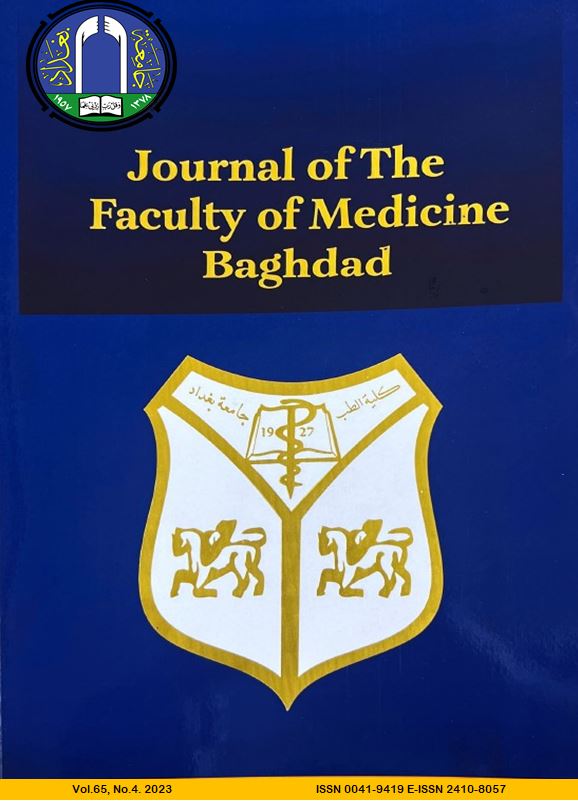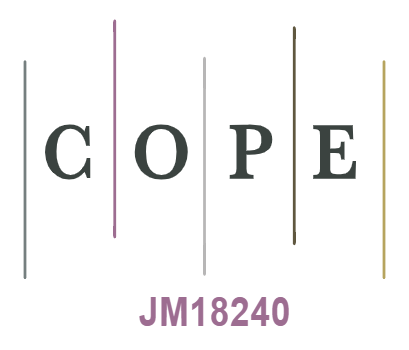Effect of Adolescent Pregnancy on Dental Caries Experience and Selected Salivary Physicochemical Characteristics
DOI:
https://doi.org/10.32007/jfacmedbagdad.2144Keywords:
Adolescent pregnancy, Dental caries , Salivary lactoferrin, Salivary flow rate, Salivary pHAbstract
Background: Adolescent pregnancy is associated with major health consequences for adolescent pregnant women, including medications and oral health problems such as dental caries and periodontal disease. Pregnancy is a unique state of physical, hormonal, and metabolic changes that can result in an oral cavity imbalance. Changes in salivary components and a decrease in salivary flow rate caused by an increase in progesterone may compromise saliva's protective effects, resulting in dental caries.
Objectives: To evaluate dental caries experience in adolescent pregnancy.
Method: A sample including 80 pregnant ladies was recruited in this study and categorized into a study group involving 40 primigravida adolescent females aged 15-19 years old and a control group involving 40 primigravida women (20-32) years old who married at age 20 years or more, all of them in the second trimester of pregnancy. Unstimulated salivary samples were collected, and salivary flow rate, pH, and dental caries experience were assessed. Saliva samples were analyzed to estimate salivary lactoferrin concentration.
Results: The mean (±sd) of decayed surfaces of the study group was (11.850±0.669) compared to (9.425±1.015) of the control group, and the level of salivary lactoferrin of the study group was (8.071±0.558) compared to (6.610±0.447) of the control group, while the mean (±sd) of a salivary flow rate of the study group was (0.349±0.020) compared to (0.540±0.157) of the control group and the mean (±sd) salivary pH was (5.935±0.053) compared to (5.995±0.153) of the control group.
Conclusion: Adolescent pregnancy is linked to increased dental caries experience by altering salivary characteristics, including lactoferrin levels.
Received: June, 2023
Revised: July, 2023
Accepted: Aug, 2023
Published: Jan. 2024
Downloads
References
1. Moni SA, Nair M, Devi RS. Pregnancy among unmarried adolescents and young adults. The Journal of Obstetrics and Gynecology of India. 2013;63:49-54. https://doi.org/10.1007/s13224-012-0244-7.
2. Farhan LO, Mustafa SA, Mubder NS. Effect of Pregnancy on Selenium, Cupper, Zinc and Others Biochemical Feacture. Baghdad Science Journal. 2013;10(4). https://doi.org/10.21123/bsj.2013.10.4.1182-1189.
3. Murphey C. Oral health experiences of pregnant and parenting adolescent women: a qualitative descriptive study. International journal of nursing studies. 2013;50(6):768-75. doi.org/10.1016/j.ijnurstu.2012.07.010. https://doi.org/10.1016/j.ijnurstu.2012.07.010.
4. Turki OH, Jafar ZJ. Antibacterial Activity of Juglans regia L. Dry Husk Extract against Streptococcus mutans and Lactobacillus: An In Vitro Study. Dental Hypotheses. 2023;14(1):29. DOI: 10.4103/denthyp.denthyp_144_22. https://doi.org/10.4103/denthyp.denthyp_144_22.
5. Silk H, Douglass AB, Douglass JM, Silk L. Oral health during pregnancy. American family physician. 2008;77(8):1139-44. https://doi.org/10.1097/00005721-200209000-00007.
6. Naveen S, Asha M, Shubha G, Bajoria A, Jose A. Salivary Flow rate, pH and buffering capacity in pregnant and non pregnant women-A comparative study. JMED research. 2014;2014(2014):1-7. https://doi.org/10.5171/2014.506946.
7. Karnik AA, Pagare SS, Krishnamurthy V, Vahanwala SP, Waghmare M. Determination of salivary flow rate, pH, and dental caries during pregnancy: A study. Journal of Indian Academy of Oral Medicine and Radiology. 2015;27(3):372-6. https://doi.org/10.4103/0972-1363.170454.
8. Fine DH, Toruner GA, Velliyagounder K, Sampathkumar V, Godboley D, Furgang D. A lactotransferrin single nucleotide polymorphism demonstrates biological activity that can reduce susceptibility to caries. Infection and immunity. 2013; 81(5): 1596-605. https://doi.org/10.1128/IAI.01063-12.
9. Drago-Serrano ME, Campos-Rodríguez R, Carrero JC, De la Garza M. Lactoferrin: balancing ups and downs of inflammation due to microbial infections. International journal of molecular sciences. 2017;18(3):501. https://doi.org/10.3390/ijms18030501.
10. Amerongen AN, Veerman E. Saliva-the defender of the oral cavity. Oral diseases. 2002;8(1):12-22. https://doi.org/10.1034/j.1601-0825.2002.1o816.x.
11. Navazesh M, Kumar SK. Measuring salivary flow: challenges and opportunities. The Journal of the American Dental Association. 2008;139:35S-40S. https://doi.org/10.14219/jada.archive.2008.0353.
12. Jensen SB, Mouridsen HT, Reibel J, Brünner N, Nauntofte B. Adjuvant chemotherapy in breast cancer patients induces temporary salivary gland hypofunction. Oral oncology. 2008;44(2):162-73. https://doi.org/10.1016/j.oraloncology.2007.01.015.
13. Carvalho SPM, Sales-Peres A, Ribeiro-Bicudo LA, Silva RHAd. Quality evaluation of DNA obtained from stored human saliva and its applicability to identification in Forensic Dentistry. Revista Odonto Ciência. 2010;25:48-53. https://doi.org/10.1590/S1980-65232010000100010.
14. Organization WH. Oral health surveys: basic methods: World Health Organization; 2013. https://www.who.int/publications-detail-redirect/9789241548649.
15. Ferraro M, Vieira AR. Explaining gender differences in caries: a multifactorial approach to a multifactorial disease. International journal of dentistry. 2010;2010. https://doi.org/10.1155/2010/649643.
16. Hom JM, Lee JY, Divaris K, Baker AD, Vann Jr WF. Oral health literacy and knowledge among patients who are pregnant for the first time. The Journal of the American Dental Association. 2012;143(9):972-80. https://doi.org/10.14219/jada.archive.2012.0322.
17. Saliba Rovida T, Saliba Moimaz S, Lima D, Saliba Garbin C. Self-perception and oral health in pregnant adolescents. Oral Health and Dental Management. 2014;13(3):842-6. https://pubmed.ncbi.nlm.nih.gov/25284568/
18. Villa A, Abati S, Pileri P, Calabrese S, Capobianco G, Strohmenger L, et al. Oral health and oral diseases in pregnancy: a multicentre survey of Italian postpartum women. Australian dental journal. 2013;58(2):224-9. https://doi.org/10.1111/adj.12058.
19. Valdés LD, Lizama RLV. The influence of mouth health in the future newborn during pregnancy. Gaceta Médica Espirituana. 2015;17(1):1-13. https://www.medigraphic.com/cgi-bin/new/resumenI.cgi?IDARTICULO=57376.
20. Suliburska J, Bogdanski P, Pupek-Musialik D, Glod-Nawrocka M, Krauss H, Piatek J. Analysis of lifestyle of young adults in the rural and urban areas. Annals of Agricultural and Environmental Medicine. 2012;19(1). https://pubmed.ncbi.nlm.nih.gov/22462458.
21. Dawood IM, El-Samarrai SK. Saliva and oral health. Int J Adv Res Biol Sci. 2018;5(7):1-45. https://doi.org/10.22192/ijarbs.2018.05.07.001.
22. González-Aragón Pineda A, García Pérez A, García-Godoy F. Salivary parameters and oral health status amongst adolescents in Mexico. BMC Oral Health. 2020;20(1):1-7. https://doi.org/10.1186/s12903-020-01182-8.
23. Jeong S-J, Apostolska S, Jankulovska M, Angelova D, Nares S, Yoon M-S, et al. Dental caries risk can be predicted by simply measuring the pH and buffering capacity of saliva. Journal of dental hygiene science. 2006; 6(3):159-62. https://koreascience.kr/article/JAKO200624851360418.page.
24. Animireddy D, Bekkem VTR, Vallala P, Kotha SB, Ankireddy S, Mohammad N. Evaluation of pH, buffering capacity, viscosity and flow rate levels of saliva in caries-free, minimal caries and nursing caries children: An in vivo study. Contemporary clinical dentistry. 2014;5(3):324. https://doi.org/10.4103/0976-237X.137931.
25. Fadavi S, Sevandal MC, Koerber A, Punwani I. Survey of oral health knowledge and behavior of pregnant minority adolescents. Pediatric Dentistry. 2009;31(5):405-8. https://pubmed.ncbi.nlm.nih.gov/19947135/.
26. Fehder WP. Nursing care & management of pathological oral conditions among women and children. MCN: The American Journal of Maternal/Child Nursing. 2008;33(1):38-44. https://doi.org/10.1097/01.NMC.0000305656.86495.e2.
27. Migliario M, Bindi M, Surico D, De Pedrini A, Minsenti S, Pezzotti F, et al. Changes in salivary flow rate and pH in pregnancy. Eur Rev Med Pharmacol Sci. 2021;25(4):1804-10. https://doi.org/10.26355/eurrev_202102_25074.
28. Kaliliou M. Saliva ovulation pregnancy tester. Br J Gynecol. 2002;11:20-3. https://scholar.google.com/scholar_lookup?title=Saliva+ovulation+pregnancy+tester&publication_year=2002&author=MV+Kaliliou.
29. Al-Nuaimy KM, Al-Doski FS. Pregnancy-related changes in oral health and human unstimulated whole saliva. Al-Rafidain Dental Journal. 2003;3(2):108-15. https://doi.org/10.33899/rden.2003.165765.
30. Issa ZMT, El-Samarrai SK. Oral health status among a group of pregnancy and lactating women in relation to salivary constituents and physical properties (A comparative study). JBCD. 2012;24(2). https://www.iasj.net/iasj/article/70077.
31. Mutlak NQ, Yas BA. Dental caries severity in relation to selected salivary variables among a group of pregnant women in Baghdad city/Iraq. JBCD. 2017;29(2):115-21. https://doi.org/10.12816/0038760.
32. Aminabadi NA, Najafpour E, Rohani ZR, Deljavan AS, Ghojazadeh M, Jamali Z. Linear reciprocal interaction between dental caries and salivary characteristics. Journal of oral science. 2013;55(4):337-42. https://doi.org/10.2334/josnusd.55.337.
33. Lukacs JR. Sex differences in dental caries experience: clinical evidence, complex etiology. Clinical oral investigations. 2011;15:649-56. https://doi.org/10.1007/s00784-010-0445-3.
34. Lomova A, Prohodnaya V, Bykov I. Lactoferrin oral liquid as a marker activity dental caries in pregnant women. Medical Bulletin of the North Caucasus. 2010;11(3):431-4. https://doi.org/10.14300/mnnc.2016.11096.
35. Hao G, Lin H. Relationship of concentration of lactoferrin and lysozyme in saliva and dental caries in primary dentition. Zhonghua kou qiang yi xue za zhi= Zhonghua kouqiang yixue zazhi= Chinese journal of stomatology. 2009;44(2):82-4. https://pubmed.ncbi.nlm.nih.gov/19563039/.
36. Felizardo KR, Gonçalves RB, Schwarcz WD, Poli-Frederico RC, Maciel SM, Andrade FBd. An evaluation of the expression profiles of salivary proteins lactoferrin and lysozyme and their association with caries experience and activity. Revista Odonto Ciência. 2010;25:344-9. https://doi.org/10.1590/S1980-65232010000400004.
37. Sikorska M, Mielnik‐Blaszczak M, Kapeć E. The relationship between the levels of SigA, lactoferrin and α1 proteinase inhibitor in saliva and permanent dentition caries in 15‐year‐olds. Oral microbiology and immunology. 2002;17(5):272-6. https://doi.org/10.1034/j.1399-302X.2002.170502.x.
38. Leone CW, Oppenheim FG. Physical and chemical aspects of saliva as indicators of risk for dental caries in humans. Journal of dental education. 2001;65(10):1054-62. https://doi.org/10.1002/j.0022-0337.2001.65.10.tb03449.x.
Downloads
Published
Issue
Section
License
Copyright (c) 2023 Balsam A. Al-jabari & Nibal M. Hoobi

This work is licensed under a Creative Commons Attribution 4.0 International License.











 Creative Commons Attribution 4.0 International license..
Creative Commons Attribution 4.0 International license..


